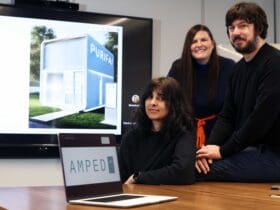Semiconductor manufacturer Kubos is set to bring its revolutionary new compound semiconductor material to South Wales, thanks to a £670,000 equity investment from the Development Bank of Wales
Kubos has chosen Cardiff University’s Sbarc building for its base, putting them at the heart of Wales’ world-class compound semiconductor eco-system. The business will recruit for five new positions including testing engineer, device manager and VP of development along with continuing technical development undertaken at Cardiff University and the University of Cambridge by Professor David Wallis and his team.
The business is working on a new compound semiconductor material called cubic gallium nitride (GaN) aimed at enabling next-generation microscopic scale, light-emitting diodes (microLEDs), which find uses in small scale displays such as smartwatches and augmented or virtual reality devices.
Kubos’ technology allows the company to improve the performance of diodes smaller than the width of a human hair, meaning they can be used in ultra-high resolution display screens for near-eye applications.
By growing cubic GaN on large area silicon carbide on silicon substrates, Kubos can reduce the cost of high efficiency green and red LEDs, tackling problems which are currently holding back the wider use of LEDs in VR and AR displays, data communications and lighting.
The Development Bank of Wales led the £2.2 million round alongside Dr Drew Nelson, founder, and president of IQE plc, the Angels Invest Wales Co-Investment Fund and business angels, together with an Innovate UK (IUK) £700,000 grant.
Caroline O’Brien, CEO at Kubos said: “The valuable support from the Development Bank of Wales has enabled us to embed Kubos within the South Wales cluster for Compound Semiconductors, leveraging the expertise and ecosystem that has developed over many years.”
Dr Carl Griffiths, fund manager in the Technology Venture Investments team at the Development Bank, said: “Kubos’ proprietary technology has the potential to improve the user experience for lighting and displays and accelerate the adoption of microLEDs across a wide range of applications.
“We are proud to have worked with this exciting company of highly acclaimed engineers and scientists, and to have helped them re-locate to Wales making use of the compound semiconductor expertise and infrastructure in the region.”








Leave a Reply
View Comments